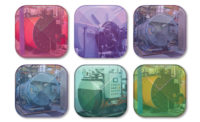Finding the holy grail of centrifugal chiller optimization for all operating conditions is hard, if not impossible. This article will talk about the requirements of most chiller systems and means of control for condenser optimization.
The most efficient location to operate a chiller is near the surge line. This article will discuss how to get the most efficient operation while protecting the chiller from operating into surge.
The following are keys to efficient surge-free operation:
-
Provide correctly sized chillers for the appropriate operating range.
-
Ensure load and condenser water supply temperature/flow stability.
-
Provide condenser relief when required.
-
Provide head pressure when required.
-
Watch fouling and approach temperatures.
-
Provide slow change to the load of the chiller and limit cyclical loading and unloading.
There are two means by which a chiller operates per its onboard controls. Some manufacturers will protect the efficiency but will let the unit get very close to the surge line or even operate at surge, while other manufacturers will operate less efficiently in order to protect the chiller as it gets close to previous conditions that caused the surge. The first approach will yield great energy savings but lower longevity and less trouble-free operation. The latter will provide higher longevity, more trouble-free operation, and less energy savings.
The key is to know how to safely maximize efficient operation without stepping beyond the bounds and operating in surge.
Chiller Sizing
The common tendency in selecting equipment is to oversize equipment. The issue with an oversized chiller is that the chiller cannot turn down, may surge, and can cycle on and off due to reaching the shutdown temperature below supply temperature setpoint. When selecting a chiller, the load profile of the facility should perform analysis for 8,760 hours with the ability to turn down the selected chiller to 30%.
Some chillers have head pressure relief required to operate at lower capacity without overshooting the setpoint due to the high differential pressure (or surging). Evaporator temperature is a result of the lift. Operating below 30% can prove to be difficult on two or more chillers operating during hot humid weather. One way to combat this is with different-sized chillers, operating them based on optimizing operation for load profile and operating hours while maintaining chiller load above 30%.
VFD centrifugal chiller optimum efficiency occurs around the 40% to 60% loading, however; with the requirements of minimum flow on both the condenser and evaporator, the optimum efficiency for the total system is towards 60% to 75% loading.
A centrifugal constant speed chiller’s optimum efficiency occurs around 70% to 90%, including the pumping energy.
Use these guides when selecting chillers, especially around the tonnage range of most hours of operation. Operating a chiller at 30% or higher could result in never approaching surge with normal operating conditions.
Tower Selection
One of the most important things for an efficient chiller plant is the ability to provide cold, condenser water supply temperature. When selecting a tower, it is important to review the chiller selection at all possible operating conditions, not just the typical ARI relief. Surprisingly, some chiller selections cannot operate at all load points with condenser water supply temperatures between 65°F to 85°F and require the condenser water supply temperature to be reset up or down.
Part of the analysis should verify that all operating points requiring a reset down are achievable even during design wet bulb days, and with at least an additional 3°F lower to account for fouling. If a chiller requires 65°F or warmer, the condenser system should have a bypass valve located on the supply side of the piping with the discharge piping trapped to prevent drain back and entraining air into the condenser system. The three-way valve shall have modulation to maintain the required condenser water supply temperature.
Chilled Water Loads and Stability
When a chiller is operating it wants slow change and steady load. Varying loads, especially those that vary quickly, put undue stress on the chiller by constantly requiring it to adjust to the load. When a variable frequency drive is used, the frequent speeding up and slowing down will stress the drive. Where inlet guide vanes are present, the repeated opening and closing will cause premature failure. As chillers hunt at low loads, below 30% of capacity, cycling on and off due to overshooting the chilled water supply setpoint and surging can occur. There are a few things that need to be done to prevent this.
1. Fan Coil & AHU CHW Valve Control
a. The chilled water valve, whether it serves a small fan coil or a large air handler, shall control the supply air discharge temperature, and the supply air discharge temperature setpoint shall be reset by either of the following three items:
i. Dewpoint setpoint for humidity requirements. This should be a fixed setpoint that should not change. If the dewpoint is above the setpoint, the supply setpoint shall be reset down until dewpoint is under control, but it should not switch from a cooling setpoint to a dehumidification setpoint. (It has been witnessed in the past that switching back and forth causes wild swings in chiller loads.)
ii. If overcooling is occurring by dehumidification, one should design for bypassing return air while dehumidifying to increase supply air temperature or reheat.
iii. Never control a space temperature (or humidity/dewpoint) directly with a control valve. Instead, the supply temperature setpoint controlling the chilled water valve should be reset to maintain the space setpoint, or humidity/dewpoint, for single-zone systems.
2. Temperature Resets
a. The temperature reset for chiller supply temperature shall occur slowly. The reset for most chillers should be in the neighborhood of 10% of a change per minute. For example, to change the temperature by 2°F, the change shall be 0.2°F per minute.
b. The primary flow in a primary variable/secondary variable system shall also be slow-changing (primary constant/secondary variable is not recommended due to multiple issues such as low delta T). The change in flow shall be about 10% of a change per minute.
c. Proper load tuning also requires less than 10% of a change per minute. If the loads can change quickly due to the nature of the load, provide a buffer tank to limit the rate of change to the chiller and the cycles of change.
Condenser Control Tower Temperature and Variable Condenser Flow
Heat transfer comprises three components:
-
Heat transfer coefficient is a function of surface area, thermal conductance of the heat exchange, and heat transfer coefficient of the refrigerant and condenser water. (This will change minimally under operation of a chiller.)
-
Log mean temperature difference (LMTD) between the refrigerant and the condenser water fluid. (This is related to the CWS temperature.)
-
Condenser water flow rate.
For most chiller technicians, only the condenser water supply (CWS) temperature is considered (LMTD) because the effects of variable condenser flow are not well known. Both temperature and flow are an important part of controlling lift on the condenser side.
What is the proper way of controlling flow and CWS temperature setpoint? For years, a fixed setpoint of 80°F to 85°F was used. However, this could lead to surge under low-load conditions from high lift. If CWS is a fixed 65°F, low lift could lead to a stall where the chiller will not move refrigerant providing cooling. This is very important on startup, when high loads are present and low lift or even inverted lift (the condenser is colder than the evaporator) can be present.
Lift is designated at the pressure difference (or temperature difference) of the refrigerant in the condenser barrel or evaporator barrel. The values of lift are based on the type of refrigerant, impellor design (single-stage or multistage), size and speed of the impellor, capacity control design (variable geometry or inlet guide vanes), and the manufacturer.
All chillers have minimum and maximum lift limits. The control sequences should take this into consideration and prevent operation outside the limits. They also have an optimum lift condition for each operating point. It is easy to control for the safety limits of minimum and maximum lift. Optimum lift is more complex to control as there are multiple variables that need to be considered.
The chilled water load cannot be optimized, i.e. the load is the load (return temperature and flow are not controllable to meet the load). However, chilled water supply (CHWS) temperature can be optimized. A higher CHWS temperature improves chiller efficiency by reducing lift; however, it has an inverse energy consequence to both the pump energy and even the ability to meet load demands (as CHWS temperature is increased, flow must increase and the LMTD must decrease to maintain the same heat transfer of the load).
Obviously, if any loads are not being met because of supply temperature alone (not dirty strainers, undersized equipment, or fouling), the setpoint should not be reset so high that pump power is proportional to the cube of the pump speed. Typically, pump energy will skyrocket past 70% speed. A rationale should be used between pump speed, pump kW/ton, and chiller kW/ton to find the optimum CHWS temperature setpoint to find the “sweet spot” between the chiller and the CHW pumps for a given operating condition.
The second part of the chiller lift equation is the condenser side. On the condenser side, both the CWS temperature and flow are fully controllable. Since flow and temperature influence lift, both can be varied to get the desired effect on lift. The variable (cooling tower fan or condenser pump) that has higher energy intensity (kW/ton) at design conditions should be reduced first when more lift is required and increased last when less lift is required.
Outside of maintaining minimum and maximum lift, the optimum lift can be decided by many methods (many engineers and control/chiller operation companies have their preferred solution). The method I have developed and use is the slow moving hunt-and-find method, or “Goldilocks” method as coined and improved upon by Jeff Haberman of Boeing. This method trends the kW/ton of the chiller, cooling tower, and condenser pump for given setpoints, then resets it down and measures if the new setpoint saves energy for the cooling tower or condenser pumps. This is repeated after some time. Then, once the kW/ton does not change or increase, the reset is operated in the opposite direction for two cycles and stopped if the kW/ton does not improve. This process is repeated an hour later, chasing the sweet spot of CWS and CW flow.
If the resets approach minimum or maximum lift, the reset is stopped. An alternate method for condenser flow is to equalize the kW/ton slope of change of the chiller versus the condenser pump. They both are at the minimum between the two.
There are many ways to control a chiller plant and hopefully this article improves your understanding of how and why (or why not) to implement some of the methods available (including the author’s own method). ES




